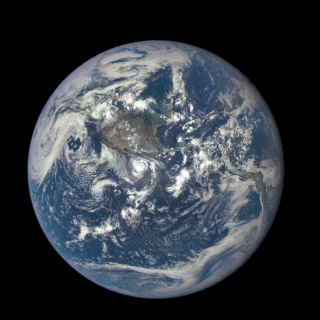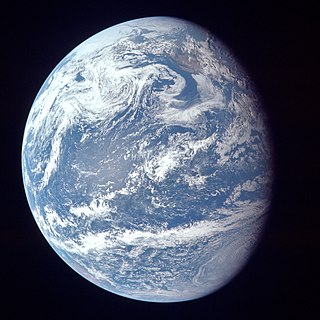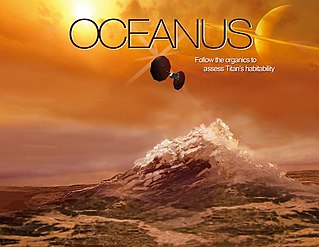Oceanus is the personification of the world-ocean in Greek myth.
Contents
Oceanus may also refer to:
Oceanus is the personification of the world-ocean in Greek myth.
Oceanus may also refer to:
Titan most often refers to:

In Greek mythology, Oceanus was a Titan son of Uranus and Gaia, the husband of his sister the Titan Tethys, and the father of the river gods and the Oceanids, as well as being the great river which encircled the entire world.

A natural satellite is, in the most common usage, an astronomical body that orbits a planet, dwarf planet, or small Solar System body. Natural satellites are colloquially referred to as moons, a derivation from the Moon of Earth.

Oberon, also designated Uranus IV, is the outermost and second-largest major moon of the planet Uranus. It is the second-most massive of the Uranian moons, and the tenth-largest moon in the Solar System. Discovered by William Herschel in 1787, Oberon is named after the mythical king of the fairies who appears as a character in Shakespeare's A Midsummer Night's Dream. Its orbit lies partially outside Uranus's magnetosphere.

Titania, also designated Uranus III, is the largest moon of Uranus. At a diameter of 1,578 kilometres (981 mi) it is the eighth largest moon in the Solar System, with a surface area comparable to that of Australia. Discovered by William Herschel in 1787, it is named after the queen of the fairies in Shakespeare's A Midsummer Night's Dream. Its orbit lies inside Uranus's magnetosphere.

Creature is a 1985 American science fiction horror film directed by William Malone, starring Stan Ivar, Wendy Schaal, Lyman Ward, Annette McCarthy, Robert Jaffe, Diane Salinger, and Klaus Kinski. It features early special effects work by Robert and Dennis Skotak, who would go on to design the special effects for Aliens.

An ocean world, ocean planet or water world is a type of planet or natural satellite that contains a substantial amount of water in the form of oceans, as part of its hydrosphere, either beneath the surface, as subsurface oceans, or on the surface, potentially submerging all dry land. The term ocean world is also used sometimes for astronomical bodies with an ocean composed of a different fluid or thalassogen, such as lava, ammonia or hydrocarbons. The study of extraterrestrial oceans is referred to as planetary oceanography.

The exploration of Uranus has, to date, been through telescopes and a lone probe by NASA's Voyager 2 spacecraft, which made its closest approach to Uranus on January 24, 1986. Voyager 2 discovered 10 moons, studied the planet's cold atmosphere, and examined its ring system, discovering two new rings. It also imaged Uranus' five large moons, revealing that their surfaces are covered with impact craters and canyons.

The Uranus Orbiter and Probe is an orbiter mission concept to study Uranus and its moons. The orbiter would also deploy an atmospheric probe to characterize Uranus's atmosphere. The concept is being developed as a potential large strategic science mission for NASA. The science phase would last 4.5 years and include multiple flybys of each of the major moons.

Uranus Pathfinder was a mission concept for the Uranian system evaluated in the 2010s by the European Space Agency. In 2011, scientists from the Mullard Space Science Laboratory in the United Kingdom proposed the joint NASA–ESA Uranus Pathfinder mission to Uranus. It would have been a medium-class (M-class) mission to be launched in 2022, and was submitted to the ESA in December 2010 with the signatures of 120 scientists from around the globe. ESA caps the cost of M-class missions at €470 million. Uranus Pathfinder was proposed in support of ESA's Cosmic Vision 2015–2025. The mission study including several possible combinations of launch dates, trajectories, and flybys, including flybys of Earth, Venus, and of the planet Saturn. Indeed, the study noted the velocity change requirements are only marginally higher than for typical missions to Saturn of this period.
Planetary oceanography, also called astro-oceanography or exo-oceanography, is the study of oceans on planets and moons other than Earth. Unlike other planetary sciences like astrobiology, astrochemistry, and planetary geology, it only began after the discovery of underground oceans in Saturn's moon Titan and Jupiter's moon Europa. This field remains speculative until further missions reach the oceans beneath the rock or ice layer of the moons. There are many theories about oceans or even ocean worlds of celestial bodies in the Solar System, from oceans made of liquid carbon with floating diamonds in Neptune to a gigantic ocean of liquid hydrogen that may exist underneath Jupiter's surface.

Wanderers is a 2014 Swedish science fiction short film created by the digital artist and animator Erik Wernquist. The film depicts actual locations in the Solar System being investigated by human explorers, aided by hypothetical space technology. Of the film's fifteen scenes, Wernquist created some using solely computer graphics, but most are based on actual photographs taken by robotic spacecraft or rovers combined with additional computer-generated elements.
MUSE is a European proposal for a dedicated mission to the planet Uranus to study its atmosphere, interior, moons, rings, and magnetosphere. It is proposed to be launched with an Ariane 6 in 2026, travel for 16.5 years to reach Uranus in 2044, and would operate until 2050.

Oceanus is a NASA/JPL orbiter mission concept proposed in 2017 for the New Frontiers mission #4, but it was not selected for development. If selected at some future opportunity, Oceanus would travel to Saturn's moon Titan to assess its habitability. Studying Titan would help understand the early Earth and exoplanets which orbit other stars. The mission is named after Oceanus, the Greek god of oceans.
Oceanus: Act One is a 2015 American adventure, science-fiction short film which is a prequel to the upcoming film Oceanus: Odyssey One created by Jeffrey Morris.

The Ocean Worlds Exploration Program (OWEP) is a NASA program to explore ocean worlds in the outer Solar System that could possess subsurface oceans to assess their habitability and to seek biosignatures of simple extraterrestrial life.

OCEANUS is a mission concept conceived in 2016 and presented in 2017 as a potential future contestant as a New Frontiers program mission to the planet Uranus. The concept was developed in a different form by the astronautical engineering students of Purdue University during the 2017 NASA/JPL Planetary Science Summer School. OCEANUS is an orbiter, which would enable a detailed study of the structure of the planet's magnetosphere and interior structure that would not be possible with a flyby mission.

Neptune Odyssey is an orbiter mission concept to study Neptune and its moons, particularly Triton. The orbiter would enter into a retrograde orbit of Neptune to facilitate simultaneous study of Triton and would launch an atmospheric probe to characterize Neptune's atmosphere. The concept is being developed as a potential large strategic science mission for NASA by a team led by the Applied Physics Laboratory at Johns Hopkins University. The current proposal targets a launch in 2033 using the Space Launch System with arrival at Neptune in 2049, although trajectories using gravity assists at Jupiter have also been considered with launch dates in 2031.

The Enceladus Orbilander is a proposed NASA Flagship mission to Saturn's moon Enceladus. The Enceladus Orbilander would spend a year and a half orbiting Enceladus and sampling its water plumes, which stretch into space, before landing on the surface for a two-year mission to study materials for evidence of life. The mission, with an estimated cost of $4.9 billion, could launch in the late 2030s on a Space Launch System or Falcon Heavy with a landing in the early 2050s. It was proposed in the 2023–2032 Planetary Science Decadal Survey as the third highest priority Flagship mission, after the Uranus Orbiter and Probe and the Mars Sample Return program.